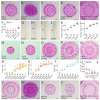SPL13 controls a root apical meristem phase change by triggering oriented cell divisions
- PMID: 39541454
- PMCID: PMC7616863
- DOI: 10.1126/science.ado4298
SPL13 controls a root apical meristem phase change by triggering oriented cell divisions
Abstract
Oriented cell divisions are crucial for determining the overall morphology and size of plants, but what controls the onset and duration of this process remains largely unknown. Here, we identified a small molecule that activates root apical meristem (RAM) expression of SQUAMOSA PROMOTER BINDING PROTEIN-LIKE13 (SPL13) a known player in the shoot's juvenile-to-adult transition. This expression leads to oriented cell divisions in the RAM through SHORT ROOT (SHR) and cell cycle regulators. We further show that the RAM has distinct juvenile and adult phases typed by morphological and molecular characteristics and that SPL factors are crucially required for this transition in Arabidopsis and rice (Oryza sativa). In summary, we provide molecular insights into the age-dependent morphological changes occurring in the RAM during phase change.
Conflict of interest statement
Figures





References
-
- Ohashi-Ito K, Fukuda H. Transcriptional networks regulating root vascular development. Curr Opin Plant Biol. 2020;57:118–123. - PubMed
-
- Ruonala R, Ko D, Helariutta Y. Genetic Networks in Plant Vascular Development. Annu Rev Genet. 2017;51:335–359. - PubMed
-
- De Rybel B, Mähönen AP, Helariutta Y, Weijers D. Plant vascular development: from early specification to differentiation. Nat Rev Mol Cell Biol. 2016;17:30–40. - PubMed
Publication types
MeSH terms
Substances
Grants and funding
LinkOut - more resources
Full Text Sources

